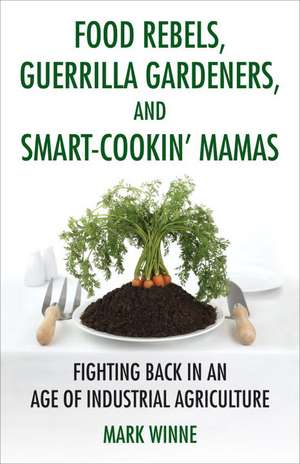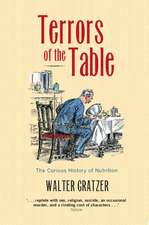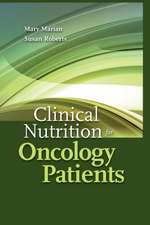Food Rebels, Guerrilla Gardeners, and Smart-Cookin' Mamas
Autor Mark Winneen Limba Engleză Paperback – 19 oct 2011
Preț: 144.51 lei
Preț vechi: 152.11 lei
-5% Nou
Puncte Express: 217
Preț estimativ în valută:
27.65€ • 28.95$ • 22.88£
27.65€ • 28.95$ • 22.88£
Carte tipărită la comandă
Livrare economică 05-19 aprilie
Preluare comenzi: 021 569.72.76
Specificații
ISBN-13: 9780807047378
ISBN-10: 0807047376
Pagini: 200
Dimensiuni: 142 x 217 x 14 mm
Greutate: 0.28 kg
Editura: Beacon Press (MA)
ISBN-10: 0807047376
Pagini: 200
Dimensiuni: 142 x 217 x 14 mm
Greutate: 0.28 kg
Editura: Beacon Press (MA)
Notă biografică
For twenty-five years, Mark Winne was the executive director of the Hartford Food System in Hartford, Connecticut. He speaks and consults extensively on community food-system topics and has written for a wide range of publications, from the Washington Post, the Nation, and Boston Globe to Successful Farming. Winne is the author of Closing the Food Gap.
From the Hardcover edition.
From the Hardcover edition.
Extras
Chapter 3
The Industrial Food System
Ministry of Plenty or Department of Destruction?
While there can be little doubt that never have so few produced so much food for so many, such abundance has come at a high cost to the environment, human health, food and agricultural workers, farm animals, wildlife, and the social and economic fabric of many American communities. Of course, that harm has not occurred everywhere, or all the time. There are indeed many good, clean, and responsible operators within the system. But there can be little question now that grievous sins have been committed and that the threat to the future is genuine.
I don’t wish to restate the long litany of damage here—volumes on that subject already exist—but only to provide a few examples of how the industrial food system has worked its will on the planet and its people. The larger question we face is whether the industrial food system can reform itself. Should we give it a shot at redemption and hope that the positive examples of a few major food system players are indeed harbingers of a new paradigm? Even for those attempting to “get right with their Lord,” we still must ask if the spirit of the Grand Inquisitor is not close to their hearts.
Conventional and Factory Farming
Conventional agriculture (nonorganic and not making comprehensive use of sustainable farming practices) relies heavily on agricultural chemicals for fertilizer, pesticides, herbicides, and fungicides. One class of pesticides, organophosphates, is made from chemicals derived from World War IIߝera nerve gases and can damage the mental and physical development of infants and children. Because of their inherent risk, scientists and environmental regulators have requested that the federal government ban twenty organophosphate pesticides. Under the administration of George W. Bush, however, the Environmental Protection Agency (EPA), which has jurisdiction over such matters, permitted the continued use of most of these. In major growing regions of the western United States, such as California’s Central Valley, much of Washington State, Oregon, and southern Arizona, the use of these harmful chemicals to grow the vast majority of America’s fresh food supply continues.
Factory farms, also known as confined animal feeding operations (CAFOs), have eclipsed pesticide use in the public’s eye as the most egregious offender in the industrial food system. Whether the land is used for raising dairy cows, beef cattle, poultry, or hogs, major sections of the United States have been “colonized” by these farms and their related operations (cheese-processing facilities, slaughter- and packinghouses), and they are massive in scale. In the eleven states of the western region, there are well over 2000 CAFOs. If one moves east into Texas, one sees enormous numbers of factory dairy and cattle farms; such towns as Hereford and Amarillo suffocate under a hazy pall of stagnant air, feedlot dust, and manure odors. Hogs rule in the Oklahoma Panhandle, where the Kerr Center has documented the decimating effect that industry has had on community life, employment, and the environment, aided and abetted by a local and state political system that’s willing to accept any industry that promises jobs. From Maryland south to North Carolina and Georgia, poultry and hog CAFOs have destroyed waterways, exploited workers (mostly immigrants), and created havoc with air quality.
While these operations are responsible for an array of outrageous abuses to people and animals, even worse are their environmental impacts, specifically in the form of air and water damage. Since CAFOs produce ungodly quantities of manure (each dairy cow, for instance, produces four tons of manure per year; one 5,000-head dairy CAFO produces as much excrement as a small city), the primary threat to the environment is in the form of nitrates percolating into both surface water and groundwater. Generally, the amount of seepage into the water supply is controlled by waste management permits granted by EPA and state environmental agencies. But the operative word here is “permit.” Pollution, up to a certain amount, is permitted; anything beyond certain levels (in the case of nitrates, no more than ten parts per million), constitutes a violation. In New Mexico, which has 300,000 dairy cows that produce enough manure each day to fill up nine Olympic-size swimming pools, two-thirds of the state’s 150 dairy CAFOs are in violation of permitted groundwater nitrate levels. And given the process of environmental monitoring and enforcement, it can take years (some are convinced it will never happen) for the state regulators to stop the pollution and force the perpetrators to clean up.
In the meantime, residents of dairy CAFO communities endure enormous hardships. Families are unable to have outdoor picnics in the warm weather because the flies are on the food before the Saran Wrap can be removed from the potato salad. One resident of eastern New Mexico told me that the entire southfacing outside wall of his house, normally light-colored stucco, becomes black with flies at certain times of the year. Even though he kills them with an insecticide one day, they are back the next. Groundwater tables have dropped so low due to the high water usage of CAFOs that homeowners must drill their wells deeper at considerable expense, not only for the drilling but also for the higher energy costs associated with pumping water a greater distance. Concern about groundwater contamination has also driven many residents to buy bottled water. Air pollution, which is monitored only sporadically in some parts of New Mexico, is also associated with asthma rates, which tend to run significantly higher in the state’s dairy regions.
CAFOs have been responsible for ruining some of the nation’s most scenic and ecologically rich waterways. In Maryland, the poultry industry went from 90 million chickens in 1960 to 270 million in 2005. As reported in the New York Times, this threefold growth also resulted in a near tripling of chicken manure generated, to 297,000 tons a year, which is largely responsible for the growth of phosphorous and nitrogen levels in the Chesapeake Bay. This pollution caused the number of oystermen who worked the bay to drop from 6,000 to fewer than 500. The heritage Chesapeake blue crab population has plummeted by 70 percent. Yes, chicken factories have succeeded in producing a skinless chicken breast for less than $2 per pound retail, but they have taken down the region’s seafood industry and probably some portion of the Chesapeake’s tourist industry at the same time. After all, who wants to go boating in the pea-green soup caused by farming’s nutrient-generated algae blooms?
As the toll mounts from factory livestock production, we see the risk to the public health change from things we can see, smell, or taste (our senses having always been our best defense against danger) to things that are not easily detectable, things that couldn’t even be imagined many years ago. Human resistance to antibiotics is one such threat. A particular strain of bacteria that, according to the Journal of the American Medical Association, is responsible for 19,000 deaths a year in the United States—that’s more than AIDS kills—is winning the war against antibiotics. The widespread nontherapeutic use of antibiotics (using them routinely on livestock as a preventative measure in factory farm situations where the risk of infection is high because animals are so tightly confined) is suspected as a culprit in the skyrocketing number of antibiotic resistance cases in humans. This seems probable given that the Union of Concerned Scientists estimates that at least 70 percent of the antibiotics used in America are fed to livestock on factory farms. Fortunately, the Obama administration is seeking a ban on antibiotic use in farm animals unless it is for the treatment of specific illnesses and done under the supervision of a veterinarian. It can be assumed that the livestock industry will fight the proposed ban, and should it lose the fight now will most likely resume the fight once the political winds shift again.
America’s medical community has also spoken out against factory livestock farming. The American Public Health Association called for a moratorium on the development of all future CAFOs until a series of environmental, health, and social issues could be scientifically addressed and resolved. In 2006 the Pew Charitable Trusts convened a commission on industrial farm animal production. This commission issued a report in 2008 recommending new laws regulating pollution from industrial farms, a phasing-out of CAFOs that restrict “natural movement and normal behavior,” a ban on hormones to promote animal growth, and an application of antitrust laws to encourage more competition and less concentration in the livestock industry.
The Industrial Food System
Ministry of Plenty or Department of Destruction?
While there can be little doubt that never have so few produced so much food for so many, such abundance has come at a high cost to the environment, human health, food and agricultural workers, farm animals, wildlife, and the social and economic fabric of many American communities. Of course, that harm has not occurred everywhere, or all the time. There are indeed many good, clean, and responsible operators within the system. But there can be little question now that grievous sins have been committed and that the threat to the future is genuine.
I don’t wish to restate the long litany of damage here—volumes on that subject already exist—but only to provide a few examples of how the industrial food system has worked its will on the planet and its people. The larger question we face is whether the industrial food system can reform itself. Should we give it a shot at redemption and hope that the positive examples of a few major food system players are indeed harbingers of a new paradigm? Even for those attempting to “get right with their Lord,” we still must ask if the spirit of the Grand Inquisitor is not close to their hearts.
Conventional and Factory Farming
Conventional agriculture (nonorganic and not making comprehensive use of sustainable farming practices) relies heavily on agricultural chemicals for fertilizer, pesticides, herbicides, and fungicides. One class of pesticides, organophosphates, is made from chemicals derived from World War IIߝera nerve gases and can damage the mental and physical development of infants and children. Because of their inherent risk, scientists and environmental regulators have requested that the federal government ban twenty organophosphate pesticides. Under the administration of George W. Bush, however, the Environmental Protection Agency (EPA), which has jurisdiction over such matters, permitted the continued use of most of these. In major growing regions of the western United States, such as California’s Central Valley, much of Washington State, Oregon, and southern Arizona, the use of these harmful chemicals to grow the vast majority of America’s fresh food supply continues.
Factory farms, also known as confined animal feeding operations (CAFOs), have eclipsed pesticide use in the public’s eye as the most egregious offender in the industrial food system. Whether the land is used for raising dairy cows, beef cattle, poultry, or hogs, major sections of the United States have been “colonized” by these farms and their related operations (cheese-processing facilities, slaughter- and packinghouses), and they are massive in scale. In the eleven states of the western region, there are well over 2000 CAFOs. If one moves east into Texas, one sees enormous numbers of factory dairy and cattle farms; such towns as Hereford and Amarillo suffocate under a hazy pall of stagnant air, feedlot dust, and manure odors. Hogs rule in the Oklahoma Panhandle, where the Kerr Center has documented the decimating effect that industry has had on community life, employment, and the environment, aided and abetted by a local and state political system that’s willing to accept any industry that promises jobs. From Maryland south to North Carolina and Georgia, poultry and hog CAFOs have destroyed waterways, exploited workers (mostly immigrants), and created havoc with air quality.
While these operations are responsible for an array of outrageous abuses to people and animals, even worse are their environmental impacts, specifically in the form of air and water damage. Since CAFOs produce ungodly quantities of manure (each dairy cow, for instance, produces four tons of manure per year; one 5,000-head dairy CAFO produces as much excrement as a small city), the primary threat to the environment is in the form of nitrates percolating into both surface water and groundwater. Generally, the amount of seepage into the water supply is controlled by waste management permits granted by EPA and state environmental agencies. But the operative word here is “permit.” Pollution, up to a certain amount, is permitted; anything beyond certain levels (in the case of nitrates, no more than ten parts per million), constitutes a violation. In New Mexico, which has 300,000 dairy cows that produce enough manure each day to fill up nine Olympic-size swimming pools, two-thirds of the state’s 150 dairy CAFOs are in violation of permitted groundwater nitrate levels. And given the process of environmental monitoring and enforcement, it can take years (some are convinced it will never happen) for the state regulators to stop the pollution and force the perpetrators to clean up.
In the meantime, residents of dairy CAFO communities endure enormous hardships. Families are unable to have outdoor picnics in the warm weather because the flies are on the food before the Saran Wrap can be removed from the potato salad. One resident of eastern New Mexico told me that the entire southfacing outside wall of his house, normally light-colored stucco, becomes black with flies at certain times of the year. Even though he kills them with an insecticide one day, they are back the next. Groundwater tables have dropped so low due to the high water usage of CAFOs that homeowners must drill their wells deeper at considerable expense, not only for the drilling but also for the higher energy costs associated with pumping water a greater distance. Concern about groundwater contamination has also driven many residents to buy bottled water. Air pollution, which is monitored only sporadically in some parts of New Mexico, is also associated with asthma rates, which tend to run significantly higher in the state’s dairy regions.
CAFOs have been responsible for ruining some of the nation’s most scenic and ecologically rich waterways. In Maryland, the poultry industry went from 90 million chickens in 1960 to 270 million in 2005. As reported in the New York Times, this threefold growth also resulted in a near tripling of chicken manure generated, to 297,000 tons a year, which is largely responsible for the growth of phosphorous and nitrogen levels in the Chesapeake Bay. This pollution caused the number of oystermen who worked the bay to drop from 6,000 to fewer than 500. The heritage Chesapeake blue crab population has plummeted by 70 percent. Yes, chicken factories have succeeded in producing a skinless chicken breast for less than $2 per pound retail, but they have taken down the region’s seafood industry and probably some portion of the Chesapeake’s tourist industry at the same time. After all, who wants to go boating in the pea-green soup caused by farming’s nutrient-generated algae blooms?
As the toll mounts from factory livestock production, we see the risk to the public health change from things we can see, smell, or taste (our senses having always been our best defense against danger) to things that are not easily detectable, things that couldn’t even be imagined many years ago. Human resistance to antibiotics is one such threat. A particular strain of bacteria that, according to the Journal of the American Medical Association, is responsible for 19,000 deaths a year in the United States—that’s more than AIDS kills—is winning the war against antibiotics. The widespread nontherapeutic use of antibiotics (using them routinely on livestock as a preventative measure in factory farm situations where the risk of infection is high because animals are so tightly confined) is suspected as a culprit in the skyrocketing number of antibiotic resistance cases in humans. This seems probable given that the Union of Concerned Scientists estimates that at least 70 percent of the antibiotics used in America are fed to livestock on factory farms. Fortunately, the Obama administration is seeking a ban on antibiotic use in farm animals unless it is for the treatment of specific illnesses and done under the supervision of a veterinarian. It can be assumed that the livestock industry will fight the proposed ban, and should it lose the fight now will most likely resume the fight once the political winds shift again.
America’s medical community has also spoken out against factory livestock farming. The American Public Health Association called for a moratorium on the development of all future CAFOs until a series of environmental, health, and social issues could be scientifically addressed and resolved. In 2006 the Pew Charitable Trusts convened a commission on industrial farm animal production. This commission issued a report in 2008 recommending new laws regulating pollution from industrial farms, a phasing-out of CAFOs that restrict “natural movement and normal behavior,” a ban on hormones to promote animal growth, and an application of antitrust laws to encourage more competition and less concentration in the livestock industry.
Recenzii
“This book is a lively, personal journey through one man’s efforts to make sustainably grown food available and affordable for regular folks. It’s a heartening but realistic take on what needs to happen—emphasis on need! Bravo, Mark!”—Meryl Streep
“A good combination of solid research and affirmative testimonials.”—Kirkus Reviews
“Food Rebels tells the stories of unsung heroes in the food movement—everyday people who realized that they had the power to change the way food and farming work in their communities and in the world, and did something about it. With these stories, Mark Winne inspires us and challenges us to take a stand for good, clean, fair, and affordable food for all.” " —Josh Viertel, president of Slow Food USA
“It’s rare for a single voice to speak so clearly to the many points of our lives that are touched by food. Mark’s approach is simple, humble, truthful, eloquent, and powerful. With stories ranging from Native American communities to Korea, Mark’s work proves the global importance and impact of food.”—Michel Nischan, chef and president/CEO of Wholesome Wave
“Aside from having one the best book titles of the year, this is one tome you'll want to gobble up if you worry about the pernicious effects of the industrial food system on our health, democracy, and souls.” —Santa Fe Literary News
“To Santa Fe food activist Mark Winne, the food on our plates is about democracy. It's about having food choices — ones that Winne thinks industrial agriculture is systematically reducing.Whether it is the fight over genetically modified seeds or who benefits from the massive federal Farm Bill, Winne thinks this food fight is one all consumers need to join in... “—The Santa Fe New Mexican
“Mark Winne has been working in the galleys of the U.S. food movement for 40 years, before there was a food movement of any note. He’s a social movement guy as much as a foodie guy. The title of his new book ߝFood Rebels, Guerilla Gardeners, and Smart-Cookin’ Mamas: Fighting Back in an Age of Industrial Agriculture — shows the role his warm and quirky sense of humor plays in allowing him to stay active in grassroots organizations for so long…”—www.wayneroberts.ca
From the Hardcover edition.
“A good combination of solid research and affirmative testimonials.”—Kirkus Reviews
“Food Rebels tells the stories of unsung heroes in the food movement—everyday people who realized that they had the power to change the way food and farming work in their communities and in the world, and did something about it. With these stories, Mark Winne inspires us and challenges us to take a stand for good, clean, fair, and affordable food for all.” " —Josh Viertel, president of Slow Food USA
“It’s rare for a single voice to speak so clearly to the many points of our lives that are touched by food. Mark’s approach is simple, humble, truthful, eloquent, and powerful. With stories ranging from Native American communities to Korea, Mark’s work proves the global importance and impact of food.”—Michel Nischan, chef and president/CEO of Wholesome Wave
“Aside from having one the best book titles of the year, this is one tome you'll want to gobble up if you worry about the pernicious effects of the industrial food system on our health, democracy, and souls.” —Santa Fe Literary News
“To Santa Fe food activist Mark Winne, the food on our plates is about democracy. It's about having food choices — ones that Winne thinks industrial agriculture is systematically reducing.Whether it is the fight over genetically modified seeds or who benefits from the massive federal Farm Bill, Winne thinks this food fight is one all consumers need to join in... “—The Santa Fe New Mexican
“Mark Winne has been working in the galleys of the U.S. food movement for 40 years, before there was a food movement of any note. He’s a social movement guy as much as a foodie guy. The title of his new book ߝFood Rebels, Guerilla Gardeners, and Smart-Cookin’ Mamas: Fighting Back in an Age of Industrial Agriculture — shows the role his warm and quirky sense of humor plays in allowing him to stay active in grassroots organizations for so long…”—www.wayneroberts.ca
From the Hardcover edition.
Cuprins
Part I: Authority or Freedom?
Chapter 1 A Food Story for our Times: November 2020
Chapter 2 The Fight for the Soul of the American Food System
Chapter 3 The Industrial Food System: Ministry of Plenty or Department of Destruction?
Part II : Leading the Charge
Chapter 4 Maurice Small and the Greening of Cleveland
Chapter 5 Me and My Meat
Chapter 6 The Farmer’s Cow
Chapter 7 God Didn’t Make Nachos
Chapter 8 Healthy Schools Grow Healthy Kids
Chapter 9 Getting Our Heads Above the Plate
Chapter 10 Food Sovereignty: The Right to Control Our Food
Chapter 11 Food Citizens, Unite!
Chapter 12 Reflections on Food Democracy: A Chat with Two Visionaries
Conclusion Finding the Fire Within
Notes
Chapter 1 A Food Story for our Times: November 2020
Chapter 2 The Fight for the Soul of the American Food System
Chapter 3 The Industrial Food System: Ministry of Plenty or Department of Destruction?
Part II : Leading the Charge
Chapter 4 Maurice Small and the Greening of Cleveland
Chapter 5 Me and My Meat
Chapter 6 The Farmer’s Cow
Chapter 7 God Didn’t Make Nachos
Chapter 8 Healthy Schools Grow Healthy Kids
Chapter 9 Getting Our Heads Above the Plate
Chapter 10 Food Sovereignty: The Right to Control Our Food
Chapter 11 Food Citizens, Unite!
Chapter 12 Reflections on Food Democracy: A Chat with Two Visionaries
Conclusion Finding the Fire Within
Notes












